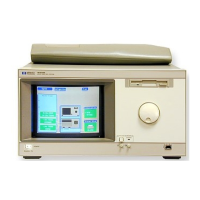Header Types
There are three types of headers: simple command, compound command,
and common command.
Simple Command Header
Simple command headers contain a single keyword. START and STOP are
examples of simple command headers. The syntax is:
<function><terminator>
When parameters (indicated by <data>) must be included with the simple
command header, the syntax is: <function><white_space><data>
<terminator>
Example :RMODE SINGLE<terminator>
Compound Command Header
Compound command headers are a combination of two or more program
keywords. The first keyword selects the subsystem, and the last keyword
selects the function within that subsystem. Sometimes you may need to list
more than one subsystem before being allowed to specify the function. The
keywords within the compound header are separated by colons. For
example, to execute a single function within a subsystem, use the following:
:<subsystem>:<function><white_space><data><terminator>
Example :SYSTEM:LONGFORM ON
To traverse down one level of a subsystem to execute a subsystem within
that subsystem, use the following:
<subsystem>:<subsystem>:<function><white_space>
<data><terminator>
Example :MMEMORY:LOAD:CONFIG "FILE "
Introduction to Programming
Header Types
1–9

